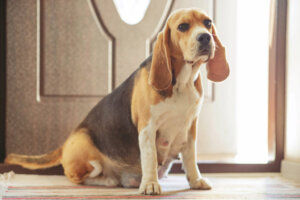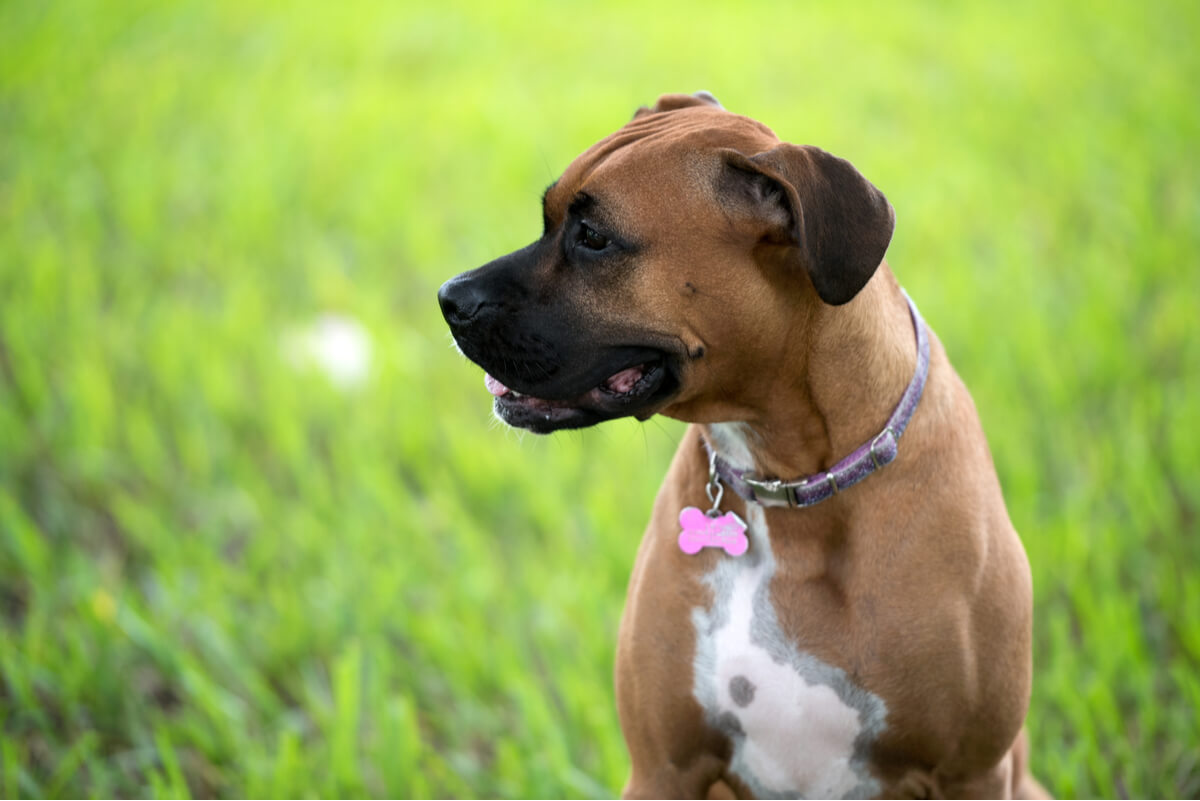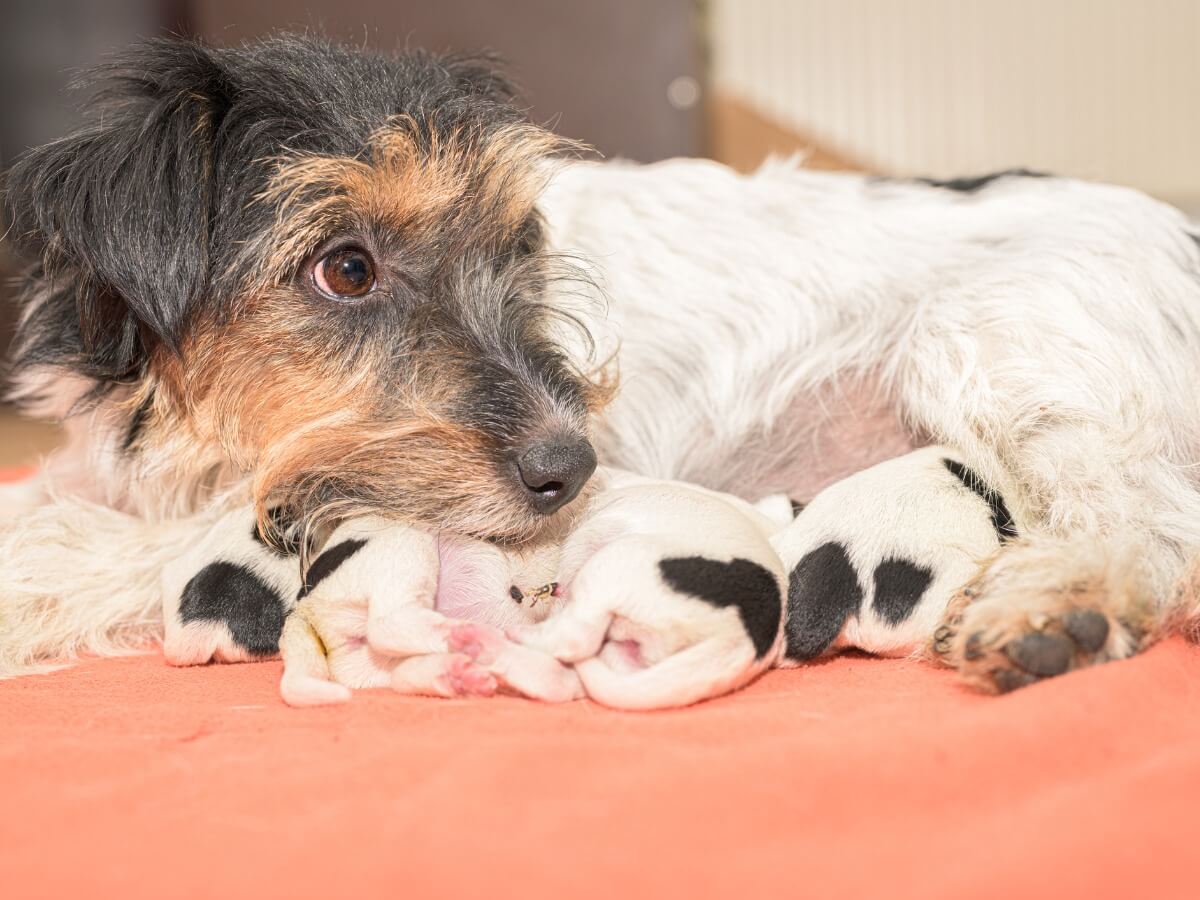When Is a Bitch in Heat Again After Giving Birth?


Written and verified by the biologist Samuel Sanchez
Reproduction is an essential part of life in all living beings, but care must be taken with certain physiological parameters of the pet if you’re trying to cross them. A bitch in heat after childbirth can be a very delicate matter.
In general, we recommend that every guardian considers spaying or neutering their bitch once she has given birth to a litter. In addition, in some countries, it’s illegal for people to force a dog to have 3 or more litters of dogs in a 12-month period, as this is considered a commercial activity and a license is required. If you want to know more about the subject, keep reading.
Heat in dogs
In domestic dogs, puppies usually reach reproductive age 6 to 12 months after birth, although the period can be as long as 2 years in larger breeds. Once they reach viability in this regard, females often enter estrous (heat) every 6 months.
The estrous phases
Dogs have an estrous cycle – a set of physiological changes induced by reproductive hormones. It’s divided into several stages. We summarize its operation in the following list:
- Proestrus: This is the period in which the tutor begins to notice changes in their dog. It usually lasts about 9 days, but can last up to 27. This is when the males pay extra attention to the female, but she doesn’t respond. The vulvar lips swell, bloody discharges occur, and the dog urinates more.
- Estrous: During proestrus, estrogen levels are very high in the bitch’s body. This causes the development of an ovarian follicle and the release of the functional egg. Then, in estrous, the female is receptive to reproduction, although the signs of heat will be a little less evident.
- Diestrus: This is the period that comes after the “in heat” stage, with a duration of about 2 months. Here the female will no longer be receptive to the male and estrogen levels are very low. On the other hand, the hormone progesterone peaks at 3-4 weeks after the onset of diestrus, but then begins to fall.
- Anestrus: Anestrus is a period of reproductive quiescence, as the female has no interest in copulation and there are no obvious signs of heat. The duration is about 4 months, and during this phase, the uterus is preparing for the next event.
Although we have shown you the general estrous cycle in dogs, it should be noted that it varies between breeds. As indicated by the VCA Hospitals portal, females of small breeds can go into heat 3 times a year, while the largest ones have only 1 cycle every 12 months.
There’s no specific period of the year that corresponds to the reproductive season in dogs. Each female has her own rhythm.

Can a bitch get pregnant in her first heat?
Small dogs can show signs of heat as early as 4 months of age, but larger dogs won’t start their cycle until 18-24 months after birth. However, the fact that a puppy can reproduce before its first year of life doesn’t mean that it should.
In general, we recommend that every owner should wait, at least until the dog has reached 2 years of age, before thinking about looking for a mate for their dog. In other words, it is best to wait until the female has already gone through 3 full heats or more.
Can a dog get pregnant without being in heat?
A female dog can’t get pregnant without being in heat. The uterine environment will not be fertile unless the hormonal cycle has occurred correctly, according to the steps we have already mentioned. However, the owner may not realize that the dog is in the proestrus or in estrous stages, as some dogs bleed very little vaginally.
On the other hand, some females may go through a “silent heat”, in which ovulation is taking place, but there are no visible symptoms. As long as there’s a fertile ovum, the bitch can have offspring, show the signs of its receptivity to varying degrees.
Heat after childbirth in dogs is possible. Even so, a female can’t get pregnant if she isn’t in heat or if she has infertility problems.
How does heat work after childbirth in dogs?
At this point, you should bear in mind that the lactation period in dogs after giving birth is very short, as puppies begin to look for other sources of food when they’re 3 or 4 weeks old (the weaning period). At this point, the female will reject the act of nursing her young and will leave them alone for increasing periods of time. By this, we mean that the interval of intensive maternal care is quite short.
A female dog will be fully prepared to continue bearing offspring on her next estrous cycle. This can be estimated at about 6 months after breeding — roughly — and about 3-4 months after giving birth. Reproductive impairment isn’t due to attachment to the puppies, but rather to the fact that it is necessary to allow time between one proestrus and the next at a hormonal level.
Heat after childbirth in dogs sets in very quickly after gestation.
What does the success of the pregnancy depend on?
As studies indicate, the miscarriage rate in dogs is 6.8%. On the other hand, the percentage of puppies that are stillborn ranges from 7.5% of the litter, and up to 13.5% of puppies can die before reaching 2 months of age. The oscillation of these parameters depends on the health of the dog, the type of cross that has occurred, the age of the female, her breed, and more.
With these figures, we want to emphasize that raising dogs is a responsibility. If you’re not clear about how your canid’s estrous cycle works or if you don’t know if it’ll be able to endure a pregnancy, go to the vet. The miracle of life is beautiful, but as long as it doesn’t put the health of the mother at risk.
How long does it take for a bitch to go into heat after giving birth?
As we have seen, postpartum heat in dogs follows a fairly fixed pattern in each dog. The estrous cycle is independent of environmental conditions and the physiological events that have taken place. Therefore, it can be generalized that a female will go into heat every 6 months. This will be independent of whether a litter has been born in this interval or not.
If we take into account that the average gestation in canines is 63 days, then it’s possible to estimate that a bitch will go into heat about 4 months after giving birth. However, some large breeds only have one heat per year, so this period can be much longer if your dog is a large breed.

The final phase: sterilization in bitches after giving birth
The most advisable thing in all cases is to sterilize the female once she has had her first litter. Heat after childbirth in dogs comes very soon, so it’s better to be prepared and go to the vet as soon as the weaning of the pups has occurred.
Control of milk production is managed in the pituitary gland of the brain – by means of the hormone prolactin. Therefore, it shouldn’t be a problem to castrate a mother even if she hasn’t finished caring for her young. However, it’s better to wait a bit and allow time for the dog’s body to return to normal before spaying her.
Reproduction is an essential part of life in all living beings, but care must be taken with certain physiological parameters of the pet if you’re trying to cross them. A bitch in heat after childbirth can be a very delicate matter.
In general, we recommend that every guardian considers spaying or neutering their bitch once she has given birth to a litter. In addition, in some countries, it’s illegal for people to force a dog to have 3 or more litters of dogs in a 12-month period, as this is considered a commercial activity and a license is required. If you want to know more about the subject, keep reading.
Heat in dogs
In domestic dogs, puppies usually reach reproductive age 6 to 12 months after birth, although the period can be as long as 2 years in larger breeds. Once they reach viability in this regard, females often enter estrous (heat) every 6 months.
The estrous phases
Dogs have an estrous cycle – a set of physiological changes induced by reproductive hormones. It’s divided into several stages. We summarize its operation in the following list:
- Proestrus: This is the period in which the tutor begins to notice changes in their dog. It usually lasts about 9 days, but can last up to 27. This is when the males pay extra attention to the female, but she doesn’t respond. The vulvar lips swell, bloody discharges occur, and the dog urinates more.
- Estrous: During proestrus, estrogen levels are very high in the bitch’s body. This causes the development of an ovarian follicle and the release of the functional egg. Then, in estrous, the female is receptive to reproduction, although the signs of heat will be a little less evident.
- Diestrus: This is the period that comes after the “in heat” stage, with a duration of about 2 months. Here the female will no longer be receptive to the male and estrogen levels are very low. On the other hand, the hormone progesterone peaks at 3-4 weeks after the onset of diestrus, but then begins to fall.
- Anestrus: Anestrus is a period of reproductive quiescence, as the female has no interest in copulation and there are no obvious signs of heat. The duration is about 4 months, and during this phase, the uterus is preparing for the next event.
Although we have shown you the general estrous cycle in dogs, it should be noted that it varies between breeds. As indicated by the VCA Hospitals portal, females of small breeds can go into heat 3 times a year, while the largest ones have only 1 cycle every 12 months.
There’s no specific period of the year that corresponds to the reproductive season in dogs. Each female has her own rhythm.

Can a bitch get pregnant in her first heat?
Small dogs can show signs of heat as early as 4 months of age, but larger dogs won’t start their cycle until 18-24 months after birth. However, the fact that a puppy can reproduce before its first year of life doesn’t mean that it should.
In general, we recommend that every owner should wait, at least until the dog has reached 2 years of age, before thinking about looking for a mate for their dog. In other words, it is best to wait until the female has already gone through 3 full heats or more.
Can a dog get pregnant without being in heat?
A female dog can’t get pregnant without being in heat. The uterine environment will not be fertile unless the hormonal cycle has occurred correctly, according to the steps we have already mentioned. However, the owner may not realize that the dog is in the proestrus or in estrous stages, as some dogs bleed very little vaginally.
On the other hand, some females may go through a “silent heat”, in which ovulation is taking place, but there are no visible symptoms. As long as there’s a fertile ovum, the bitch can have offspring, show the signs of its receptivity to varying degrees.
Heat after childbirth in dogs is possible. Even so, a female can’t get pregnant if she isn’t in heat or if she has infertility problems.
How does heat work after childbirth in dogs?
At this point, you should bear in mind that the lactation period in dogs after giving birth is very short, as puppies begin to look for other sources of food when they’re 3 or 4 weeks old (the weaning period). At this point, the female will reject the act of nursing her young and will leave them alone for increasing periods of time. By this, we mean that the interval of intensive maternal care is quite short.
A female dog will be fully prepared to continue bearing offspring on her next estrous cycle. This can be estimated at about 6 months after breeding — roughly — and about 3-4 months after giving birth. Reproductive impairment isn’t due to attachment to the puppies, but rather to the fact that it is necessary to allow time between one proestrus and the next at a hormonal level.
Heat after childbirth in dogs sets in very quickly after gestation.
What does the success of the pregnancy depend on?
As studies indicate, the miscarriage rate in dogs is 6.8%. On the other hand, the percentage of puppies that are stillborn ranges from 7.5% of the litter, and up to 13.5% of puppies can die before reaching 2 months of age. The oscillation of these parameters depends on the health of the dog, the type of cross that has occurred, the age of the female, her breed, and more.
With these figures, we want to emphasize that raising dogs is a responsibility. If you’re not clear about how your canid’s estrous cycle works or if you don’t know if it’ll be able to endure a pregnancy, go to the vet. The miracle of life is beautiful, but as long as it doesn’t put the health of the mother at risk.
How long does it take for a bitch to go into heat after giving birth?
As we have seen, postpartum heat in dogs follows a fairly fixed pattern in each dog. The estrous cycle is independent of environmental conditions and the physiological events that have taken place. Therefore, it can be generalized that a female will go into heat every 6 months. This will be independent of whether a litter has been born in this interval or not.
If we take into account that the average gestation in canines is 63 days, then it’s possible to estimate that a bitch will go into heat about 4 months after giving birth. However, some large breeds only have one heat per year, so this period can be much longer if your dog is a large breed.

The final phase: sterilization in bitches after giving birth
The most advisable thing in all cases is to sterilize the female once she has had her first litter. Heat after childbirth in dogs comes very soon, so it’s better to be prepared and go to the vet as soon as the weaning of the pups has occurred.
Control of milk production is managed in the pituitary gland of the brain – by means of the hormone prolactin. Therefore, it shouldn’t be a problem to castrate a mother even if she hasn’t finished caring for her young. However, it’s better to wait a bit and allow time for the dog’s body to return to normal before spaying her.
All cited sources were thoroughly reviewed by our team to ensure their quality, reliability, currency, and validity. The bibliography of this article was considered reliable and of academic or scientific accuracy.
- Concannon, P. W. (2011). Reproductive cycles of the domestic bitch. Animal Reproduction Science, 124(3-4), 200–210.
https://pubmed.ncbi.nlm.nih.gov/21055888/ - Gaviria, E. F. B., Bonilla, D. F. E., Sánchez, I. X. B., & Quintero, A. (2013). Evaluación reproductiva de la hembra canina en el momento del servicio: consideraciones para la práctica clínica. Revista Colombiana de Ciencia Animal, 6(1), 113-117. http://revistas.ut.edu.co/index.php/ciencianimal/article/view/473
- Llera, R., & Yuill, C. (s.f.). Estrous cycles in dogs. VCA Hospitals. Recuperado el 15 de junio de 2021, disponible en: https://vcacanada.com/know-your-pet/estrus-cycles-in-dogs
- The Paws Clinic. (2013). Spay/neuter facts. Recuperado el 15 de junio de 2021, disponible en: https://thepawsclinic.com/resources/spayneuter-faqs/
- Starff, A. (2020). Sexual maturity in dogs: what to know and what to expect, American Kennel Club. Recuperado el 15 de junio de 2021, disponible en: https://www.akc.org/expert-advice/health/sexual-maturity-in-puppies-what-to-expect/
- Tonnenssen, R., Sverdrup, K., Nodvedt, A., & Indrebo, A. (2012). Canine perinatal mortality: A cohort study of 224 breeds. Theriogenology, 77(9), 1788-1801. https://www.sciencedirect.com/science/article/abs/pii/S0093691X11006819?via%3Dihub
- Ward, E. (s.f.). Breeding for pet owners- pregnancy in dogs. VCA Animal Hospitals. Recuperado el 15 de junio de 2021, disponible en: https://vcahospitals.com/know-your-pet/breeding-for-pet-owners-pregnancy-in-dogs
- Weir, M., & Barnette, C. (s.f.). Infertility in female dogs, VCA Hospitals. Recuperado el 15 de junio de 2021, disponible en: https://vcahospitals.com/know-your-pet/infertility-in-female-dogs
This text is provided for informational purposes only and does not replace consultation with a professional. If in doubt, consult your specialist.








